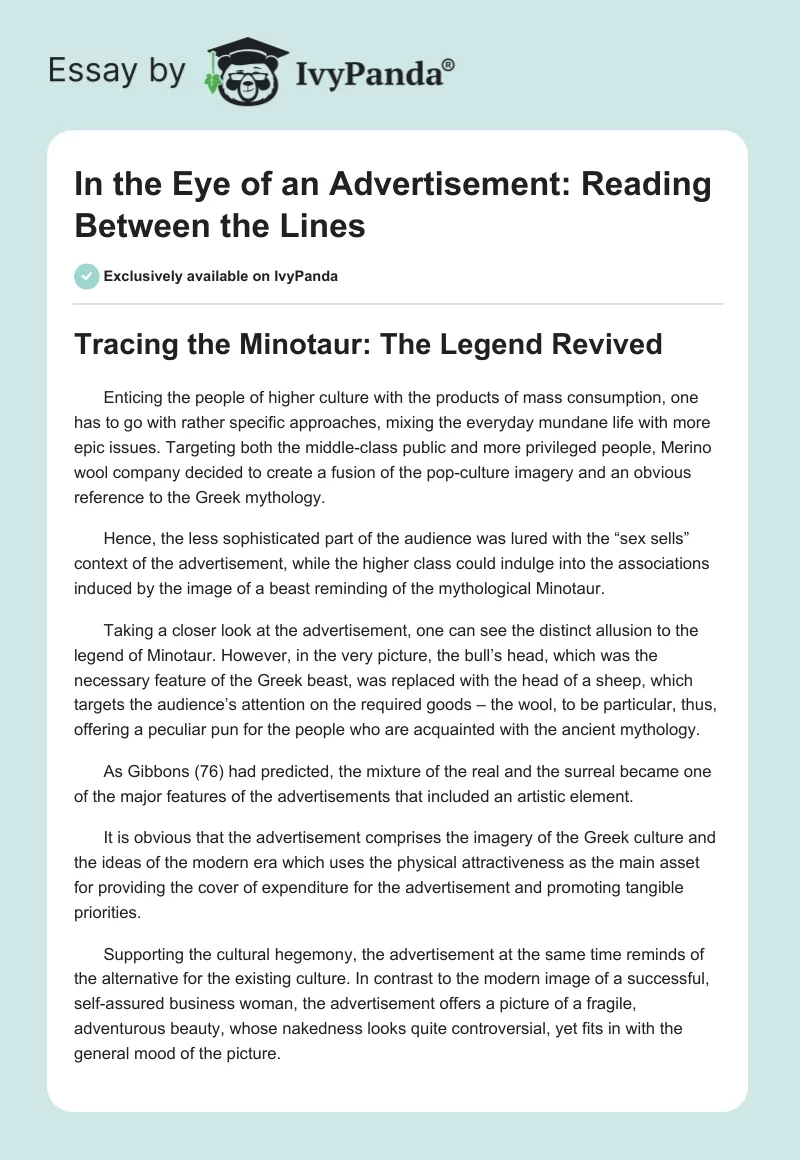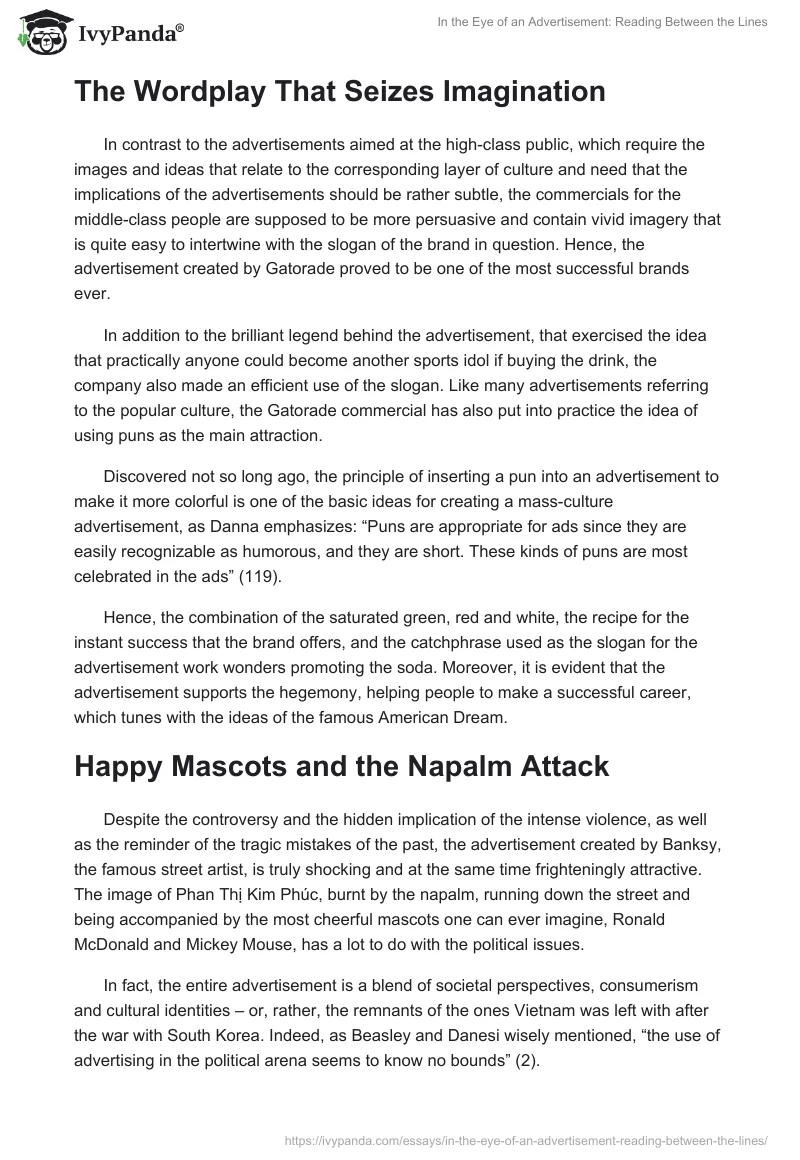Tracing the Minotaur: The Legend Revived
Enticing the people of higher culture with the products of mass consumption, one has to go with rather specific approaches, mixing the everyday mundane life with more epic issues. Targeting both the middle-class public and more privileged people, Merino wool company decided to create a fusion of the pop-culture imagery and an obvious reference to the Greek mythology.
Hence, the less sophisticated part of the audience was lured with the “sex sells” context of the advertisement, while the higher class could indulge into the associations induced by the image of a beast reminding of the mythological Minotaur.
Taking a closer look at the advertisement, one can see the distinct allusion to the legend of Minotaur. However, in the very picture, the bull’s head, which was the necessary feature of the Greek beast, was replaced with the head of a sheep, which targets the audience’s attention on the required goods – the wool, to be particular, thus, offering a peculiar pun for the people who are acquainted with the ancient mythology.
As Gibbons (76) had predicted, the mixture of the real and the surreal became one of the major features of the advertisements that included an artistic element.
It is obvious that the advertisement comprises the imagery of the Greek culture and the ideas of the modern era which uses the physical attractiveness as the main asset for providing the cover of expenditure for the advertisement and promoting tangible priorities.
Supporting the cultural hegemony, the advertisement at the same time reminds of the alternative for the existing culture. In contrast to the modern image of a successful, self-assured business woman, the advertisement offers a picture of a fragile, adventurous beauty, whose nakedness looks quite controversial, yet fits in with the general mood of the picture.
The Wordplay That Seizes Imagination
In contrast to the advertisements aimed at the high-class public, which require the images and ideas that relate to the corresponding layer of culture and need that the implications of the advertisements should be rather subtle, the commercials for the middle-class people are supposed to be more persuasive and contain vivid imagery that is quite easy to intertwine with the slogan of the brand in question. Hence, the advertisement created by Gatorade proved to be one of the most successful brands ever.
In addition to the brilliant legend behind the advertisement, that exercised the idea that practically anyone could become another sports idol if buying the drink, the company also made an efficient use of the slogan. Like many advertisements referring to the popular culture, the Gatorade commercial has also put into practice the idea of using puns as the main attraction.
Discovered not so long ago, the principle of inserting a pun into an advertisement to make it more colorful is one of the basic ideas for creating a mass-culture advertisement, as Danna emphasizes: “Puns are appropriate for ads since they are easily recognizable as humorous, and they are short. These kinds of puns are most celebrated in the ads” (119).
Hence, the combination of the saturated green, red and white, the recipe for the instant success that the brand offers, and the catchphrase used as the slogan for the advertisement work wonders promoting the soda. Moreover, it is evident that the advertisement supports the hegemony, helping people to make a successful career, which tunes with the ideas of the famous American Dream.
Happy Mascots and the Napalm Attack
Despite the controversy and the hidden implication of the intense violence, as well as the reminder of the tragic mistakes of the past, the advertisement created by Banksy, the famous street artist, is truly shocking and at the same time frighteningly attractive. The image of Phan Thị Kim Phúc, burnt by the napalm, running down the street and being accompanied by the most cheerful mascots one can ever imagine, Ronald McDonald and Mickey Mouse, has a lot to do with the political issues.
In fact, the entire advertisement is a blend of societal perspectives, consumerism and cultural identities – or, rather, the remnants of the ones Vietnam was left with after the war with South Korea. Indeed, as Beasley and Danesi wisely mentioned, “the use of advertising in the political arena seems to know no bounds” (2).
Even though the advertisement seems to be suitable for all grown-up people to think of the deplorable effects the war between Vietnam and the South Korea had, the message between the lines of the advertisement is aimed at the U. S. foreign politics and at the country’s political leaders.
Criticizing the actions undertaken by the then United States President, Richard Nixon, Banksy lunged against the policy of the government. Delivering the message of the suffering the Vietnamese had to take, Banksy revealed the political and social facts people were unaware of, which made the advertisement controversial and headed against the then hegemony.
Therefore, advertisements above tell a lot both about the culture of the nation and the relationships of the latter with the rest of the world. Being another reality that mirrors the world people live in, advertisements can be both encouraging and criticizing. One of the means for people to see their own selves, advertisements cannot change the culture, but can show the ways to shape the existing tastes and tendencies.
Works Cited
Beasley, Ron, and Marcel Danesi. Persuasive Signs: The Semiotics of Advertising. Berlin, DE: Walter de Gruyter, 2002. Print.
Danna, Sammy Richard. Advertising and Popular Culture: Studies in Variety and Versatility. The Upper Midwest, WI: Popular Press, 1992. Print.
Gibbons, Joan. Art and Advertising. London, UK: I. B. Tauris, 2005. Print.


